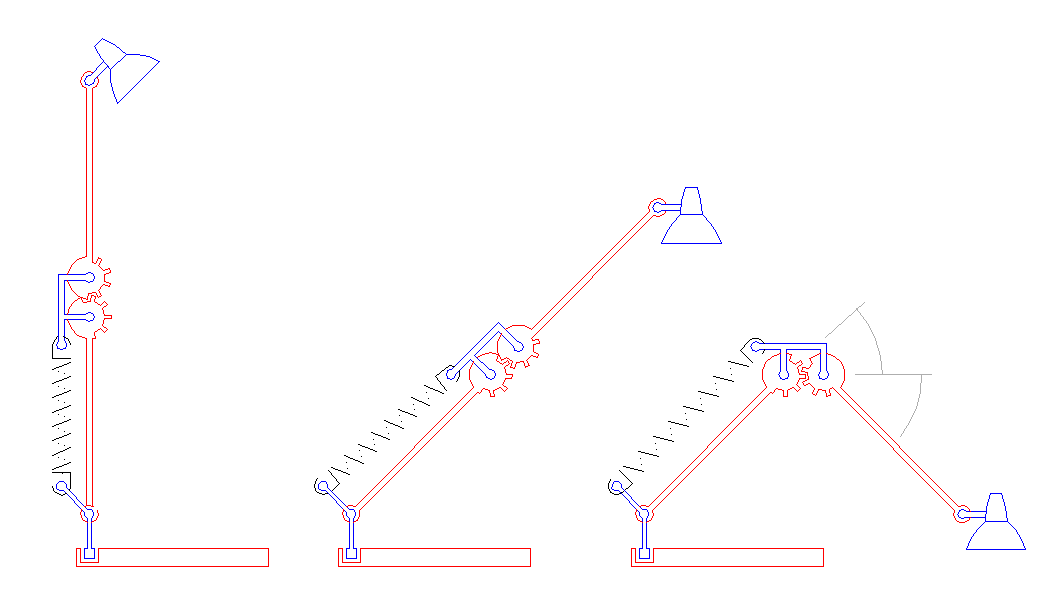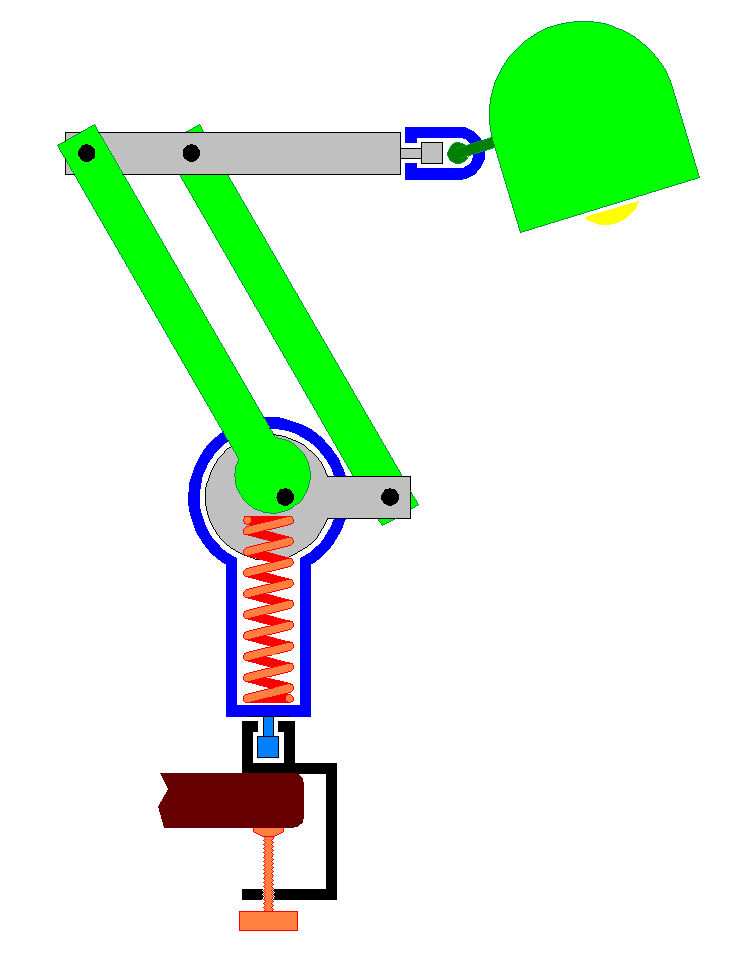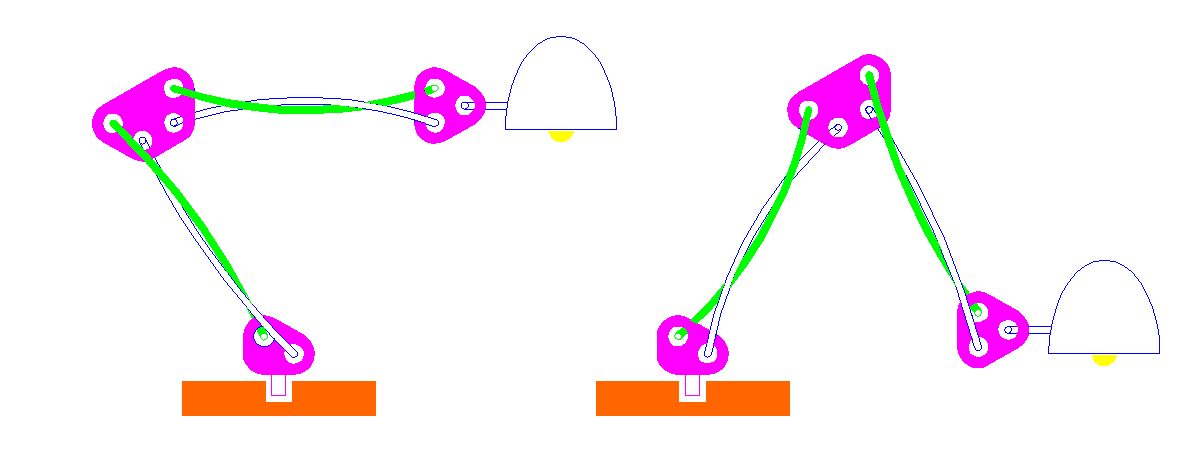
A balanced-arm lamp, sometimes called a floating arm lamp, is a lamp with an adjustable folding arm which is constructed such that the force due to gravity is always counteracted by springs, regardless of the position of the arms of the lamp. Many lamp brands (such as the
Anglepoise, originator of the concept, and
Luxo L-1), as well as other devices, use this principle.
Configuration
The five terms
This article uses the terminology:
* ''lamp cap'',
* ''forearm'',
* ''upper arm'',
* ''stand'' or ''body'' and
* ''base''
for the five basic parts of these lamps.
The general design
A balanced-arm lamp has a ''base'', a ''stand'' or ''body'', (in most cases) ''two'' connected ''arms'' (in many cases fitted with springs), and a ''lamp-head''.
The lamp can be moved into almost any position, and the balancing device will maintain the position until moved again.
The same overall mechanism can be employed in ''other'' devices with similar requirements, such as:
* copy holders for typists,
* microphone holders in studios or
* computer display holders.
For the
physics
Physics is the natural science that studies matter, its fundamental constituents, its motion and behavior through space and time, and the related entities of energy and force. "Physical science is that department of knowledge which r ...
and theory behind balanced-arm lamps, see
Classical mechanics
Classical mechanics is a physical theory describing the motion of macroscopic objects, from projectiles to parts of machinery, and astronomical objects, such as spacecraft, planets, stars, and galaxies. For objects governed by classi ...
,
linkage and
torque
In physics and mechanics, torque is the rotational equivalent of linear force. It is also referred to as the moment of force (also abbreviated to moment). It represents the capability of a force to produce change in the rotational motion of th ...
.
There are different methods to balance the arms and the lamp-cap:
*
coil spring
A selection of conical coil springs
The most common type of spring is the coil spring, which is made out of a long piece of metal that is wound around itself.
Coil springs were in use in Roman times, evidence of this can be found in bronze Fib ...
s
In some cases a set of ''two'' coil springs working in parallel on both sides of the pivoting arm is used.
(They function in the same way as a ''single'' spring.)
*
counterweight
A counterweight is a weight that, by applying an opposite force, provides balance and stability of a mechanical system. The purpose of a counterweight is to make lifting the load faster and more efficient, which saves energy and causes less wea ...
(s)
(a method frequently used in
Sash windows and
drawing board
A drawing board (also drawing table, drafting table or architect's table) is, in its antique form, a kind of multipurpose desk which can be used for any kind of drawing, writing or impromptu sketching on a large sheet of paper or for reading a l ...
s).
*
Friction
Friction is the force resisting the relative motion of solid surfaces, fluid layers, and material elements sliding against each other. There are several types of friction:
*Dry friction is a force that opposes the relative lateral motion of ...
between parts of the lamp arm,
* Coupling or
* hydraulics or pneumatic arms.
Lamps balanced with springs
There are many variations of construction with
springs. Springs can be located on the mechanical equivalent of the forearm or the upper arm, or both, as well as nearer to the base. Some lamps use tension springs, and others use compression springs. The adjacent image shows (left to right) a compression spring at rest, then under load, followed by a tension spring at rest, and then under load.
Springs have a limited lifting capacity and extension length.
Some springs can resonate, producing low-level unwanted noise.
One tension spring
Spring-balanced upper arm, flexible forearm

This lamp has a stiff flexible tube as its forearm, and a spring-balanced arm to support it near the middle. That way there is a flexible lamp with a long reach.
Tension spring over wheels

The wheel to control the forearm is smaller than the wheel that controls the upper arm.
The lamp cap rotates the same direction as the upper arm and forearm.
Two arms, one spring, one toothed wheel

With this technique the tension spring has a double function: it controls both the forearm and the upper arm. This is not a common arm lamp system.
The lamp cap rotates the same direction as the upper arm and forearm.
Two tension springs
Two parallelograms and two tension spring sets

One tension spring set controls the forearm, which is a
parallelogram having two bars. A stronger spring set controls the upper arm, which has three parallel bars (see photo, left). (There is a less stable construction with two parallel bars in the upper arm which is less expensive to manufacture.) Due to the parallel
linkage of the lamp, the lamp cap keeps pointing in the same vertical direction when adjusting the height of the lamp. As with most balanced-arm lamps, the whole assembly can rotate in the horizontal plane, and is mounted on a stable foot.
One parallelogram and two extension spring sets

A lamp like the
Anglepoise lamp
The Anglepoise lamp is a balanced-arm lamp designed in 1932 by British designer George Carwardine.
History and development
George Carwardine (1887–1947) was a car designer and, at the same time he invented the Anglepoise lamp, (as a freela ...
has one
parallelogram and two extension springs. One spring controls the shortest arm of a parallelogram. Parallel to this shortest arm there is the forearm. To keep these arms parallel there are two other parallel arms (upper arm) that are controlled by a second extension spring.
The lamp cap rotates the same direction as the upper arm and forearm.
Single forearm bar, one parallelogram, two tension spring sets

The forearm of this lamp consist of a single bar. When it is adjusted, the angle of the lamp cap changes along with the arm.
Tension springs within the arms
A lamp like the
Tolomeo desk lamp has no
parallelograms in either arm. In this modern lamp the tension springs are hidden in the arms. The lamp cap rotates the same direction as the upper arm and forearm.
Compression springs
Compression springs in the arms

The short arms (green) stay parallel. One spring puts pull
force on the blue arm. (If the blue arm is tilted back the second spring on this arm gets push force.) The blue arm controls the two parallel arms (red) that make up the upper arm. The other spring puts pull force on the other blue arm. This arm controls the forearm (magenta). The two springs can be the same size; one spring has to lift more
weight
In science and engineering, the weight of an object is the force acting on the object due to gravity.
Some standard textbooks define weight as a vector quantity, the gravitational force acting on the object. Others define weight as a scalar qua ...
but is more vertical. The other spring lifts less weight but is more horizontal.
Compression springs near the foot
One compression spring controls a very short arm (grey). The
Roller chain
Roller chain or bush roller chain is the type of chain drive most commonly used for transmission of mechanical power on many kinds of domestic, industrial and agricultural machinery, including conveyors, wire- and tube-drawing machines, pri ...
cable
Cable may refer to:
Mechanical
* Nautical cable, an assembly of three or more ropes woven against the weave of the ropes, rendering it virtually waterproof
* Wire rope, a type of rope that consists of several strands of metal wire laid into a hel ...
connects this arm parallel to the forearm (yellow). The longer spring controls the (blue) arm. The body (red) can turn in the horizontal plane. The body is connected to a stable foot. The body can be smaller because the pressure springs can protrude below the body.
A compression spring with one parallelogram

In this method, just one compression spring controls a pantographic arm.
Lamps balanced by pressure and friction
Rubber between two "parallel" arms
In this construction (commonly found in Italian lamps) gravity causes the parallelogram to deform such that the gap between the long arms becomes smaller. This in turn increases pressure on the
rubber
Rubber, also called India rubber, latex, Amazonian rubber, ''caucho'', or ''caoutchouc'', as initially produced, consists of polymers of the organic compound isoprene, with minor impurities of other organic compounds. Thailand, Malaysia, an ...
in the gap, and the resulting
friction
Friction is the force resisting the relative motion of solid surfaces, fluid layers, and material elements sliding against each other. There are several types of friction:
*Dry friction is a force that opposes the relative lateral motion of ...
holds the arm in place.
Friction from twisting

The
friction
Friction is the force resisting the relative motion of solid surfaces, fluid layers, and material elements sliding against each other. There are several types of friction:
*Dry friction is a force that opposes the relative lateral motion of ...
between the twisted arm controls the movement between the arms.
Friction between the ''upper'' arm and the ''fore''arm

This arm system also works with friction.
Lamps balanced with counterweight
Lamps balanced with ''one'' counterweight
Advantages of one swinging counterbalance is that the lamp can have a longer arm length.
Disadvantages are that the lamp is inherently less balanced, thus it needs a heavy stand to remain stable.
A single counterweight

This construction uses a chain to keep the arm with the
counterweight
A counterweight is a weight that, by applying an opposite force, provides balance and stability of a mechanical system. The purpose of a counterweight is to make lifting the load faster and more efficient, which saves energy and causes less wea ...
and the forearm parallel. The lamp-cap and counterweight move in opposite directions (both away from the base or both towards it). The balance that is required is shown by the following formula:
:d
1 = Lamp-cap to base; m
1 = weight of lamp-cap
:d
2 = counterweight to base; m
2 = weight of counterweight
:m
1 × d
1 = m
2 × d
2
One parallelogram with one counterweight

This lamp has a heavy base, with a parallelogram
pantograph
A pantograph (, from their original use for copying writing) is a mechanical linkage connected in a manner based on parallelograms so that the movement of one pen, in tracing an image, produces identical movements in a second pen. If a line dr ...
construction formed by bars which are all hinged on each other. One long bar extends past the parallelogram construction and has a
counterweight
A counterweight is a weight that, by applying an opposite force, provides balance and stability of a mechanical system. The purpose of a counterweight is to make lifting the load faster and more efficient, which saves energy and causes less wea ...
. One short bar also extends past the parallelogram construction and holds the lamp cap.
The base has an arc formed stand so the counterweight does not hit the stand in vertical position.
One parallelogram with an extended counterweight

This lamp is similar to the one above, but as the counterweight has a low position the lamp needs no heavy foot for
stability
Stability may refer to:
Mathematics
*Stability theory, the study of the stability of solutions to differential equations and dynamical systems
** Asymptotic stability
** Linear stability
** Lyapunov stability
** Orbital stability
** Structural sta ...
as the center of gravity is low.
The counterbalance does not swing, but slides and rotates safely around the center of the stand.
Three parallelograms with one counterweight

This lamp stand has a complex construction with matching narrow openings.
This lamp is out of production .
Lamps balanced with ''two'' counterweights
A single arm with two counterweights

With this lamp the movement is very limited (the arm moves up and down only) but the technique is nice to look at. As the forearm becomes more horizontal the
weight
In science and engineering, the weight of an object is the force acting on the object due to gravity.
Some standard textbooks define weight as a vector quantity, the gravitational force acting on the object. Others define weight as a scalar qua ...
ceases to be balanced on both side of the base. The weight of the base is needed to avoid over-balancing.
Two arms with two counterweights
A lamp type like the
Tizio works like this. A balancing arm (the forearm) has on one side of an axis a small
counterweight
A counterweight is a weight that, by applying an opposite force, provides balance and stability of a mechanical system. The purpose of a counterweight is to make lifting the load faster and more efficient, which saves energy and causes less wea ...
and on the other side a lamp cap. These parts are lifted by a second bigger balancing arm (the upper arm) that has on the other side of a second axis a heavier counterweight. The lamp designed by Edouard-Wilfrid Buquet in 1927 works in this way. The lamp is in the collection of the
Museum of Modern Art
The Museum of Modern Art (MoMA) is an art museum located in Midtown Manhattan, New York City, on 53rd Street between Fifth and Sixth Avenues.
It plays a major role in developing and collecting modern art, and is often identified as one of ...
. The two axes have a different angle, and this has some advantages.
Lamp-cap x fore-Arm = Arm x Small weight (Lamp-cap + Small weight) x upper-arm = Arm x Big weight.

Lamps using other systems
Here are some less common ways of balancing arms.
Lamps having a vertical axis

This kind of lamp has a forearm balanced by weight or springs. Its disadvantage is that the upper arm cannot point up or forwards.
Mechanical coupling devices

This lamp works by
coupling
A coupling is a device used to connect two shafts together at their ends for the purpose of transmitting power. The primary purpose of couplings is to join two pieces of rotating equipment while permitting some degree of misalignment or end mov ...
together the upper arm and the forearm. It is called a gravity-locked or cam-locked elbow.
Hydraulic arm

The pivoting arm
streetlamp
A street light, light pole, lamp pole, lamppost, street lamp, light standard, or lamp standard is a raised source of light on the edge of a road or path. Similar lights may be found on a railway platform. When urban electric power distribution ...
s in the
Schouwburgplein, Rotterdam use a pair of
hydraulic cylinder
A hydraulic cylinder (also called a linear hydraulic motor) is a mechanical actuator that is used to give a unidirectional force through a unidirectional stroke. It has many applications, notably in construction equipment ( engineering vehicles ...
s to control the forearm and upper arm.
Pneumatic arm

Arm lamp with a pneumatic cylinder. The gravity compress the air in the pneumatic cylinder.
In popular culture
* Two spring-balanced desk lamps of this type feature as the main characters in the 1986
Pixar
Pixar Animation Studios (commonly known as Pixar () and stylized as P I X A R) is an American computer animation studio known for its critically and commercially successful computer animated feature films. It is based in Emeryville, Californ ...
short film ''
Luxo Jr.''. It also serves as the letter I in the Pixar logo presented before and at the end of each of their films.
*
Myster Shadow-Sky is the only composer who from 1980 to 2007 performed the balanced-arm lamp as a musical instrument: the archisonic lamp. In 1980 he wrote the score "Ludus Musicae Temporarium" for a balanced arm lamp orchestra. The world premiere was performed by
Les Percussions de Strasbourg at the Manca contemporary music festival in Nice in 1988. He released five albums with a four spring balanced arm lamp musical instrument (and more with other musical instruments). They are available for free download.
Referenced in the book "Les chercheurs de sons" (2004), as the unique creator of a balanced arm lamp as a musical instrument.
See also
*
Engineering science and mechanics
*
Gooseneck lamp
A gooseneck lamp is a type of light fixture in which a lamp or lightbulb is attached to a flexible, adjustable shaft known as a " gooseneck" to allow the user to position the light source without moving the fixture or item to be illuminated. Goo ...
*
Industrial design
*
Light fixture
A light fixture (US English), light fitting (UK English), or luminaire is an electrical device containing an electric lamp that provides illumination. All light fixtures have a fixture body and one or more lamps. The lamps may be in sockets for ...
*
Mechanical advantage
Mechanical advantage is a measure of the force amplification achieved by using a tool, mechanical device or machine system. The device trades off input forces against movement to obtain a desired amplification in the output force. The model for ...
*
Mechanical engineering technology
*
Moment (physics)
In physics, a moment is a mathematical expression involving the product of a distance and physical quantity. Moments are usually defined with respect to a fixed reference point and refer to physical quantities located some distance from the ref ...
*
Torsion spring
Patents history
Classifications IPC: F21V21/26
International patent category: B23B31/171
GB191104491An Improved Device for Supporting or Suspending Electric Lamps and the like (1911)
* - 1921 harmonica arm
1923 parallelogram & counter weight
1926 friction
1929 2 counter weight
1934 spring and counter weight
* FR757890 1934 CARWARDINE GEORGE
* FR784932 1935 CARWARDINE GEORGE
1937 friction
1938 2 parallelogram 2 springs
1939 2 pressure springs
19.. a-symmetric arm-lamp
1947 friction and a spring
1949
1949 spring in the arm
1954 friction arm
# -- 1961
1971
* - 1991 -
* EP0518569 1992
* EP1274545 2003 mechanical coupling devices
References
{{Artificial light sources
Light fixtures
 A balanced-arm lamp, sometimes called a floating arm lamp, is a lamp with an adjustable folding arm which is constructed such that the force due to gravity is always counteracted by springs, regardless of the position of the arms of the lamp. Many lamp brands (such as the Anglepoise, originator of the concept, and Luxo L-1), as well as other devices, use this principle.
A balanced-arm lamp, sometimes called a floating arm lamp, is a lamp with an adjustable folding arm which is constructed such that the force due to gravity is always counteracted by springs, regardless of the position of the arms of the lamp. Many lamp brands (such as the Anglepoise, originator of the concept, and Luxo L-1), as well as other devices, use this principle.
 One tension spring set controls the forearm, which is a parallelogram having two bars. A stronger spring set controls the upper arm, which has three parallel bars (see photo, left). (There is a less stable construction with two parallel bars in the upper arm which is less expensive to manufacture.) Due to the parallel linkage of the lamp, the lamp cap keeps pointing in the same vertical direction when adjusting the height of the lamp. As with most balanced-arm lamps, the whole assembly can rotate in the horizontal plane, and is mounted on a stable foot.
One tension spring set controls the forearm, which is a parallelogram having two bars. A stronger spring set controls the upper arm, which has three parallel bars (see photo, left). (There is a less stable construction with two parallel bars in the upper arm which is less expensive to manufacture.) Due to the parallel linkage of the lamp, the lamp cap keeps pointing in the same vertical direction when adjusting the height of the lamp. As with most balanced-arm lamps, the whole assembly can rotate in the horizontal plane, and is mounted on a stable foot.
 A lamp like the
A lamp like the  This lamp is similar to the one above, but as the counterweight has a low position the lamp needs no heavy foot for
This lamp is similar to the one above, but as the counterweight has a low position the lamp needs no heavy foot for 
 The pivoting arm
The pivoting arm